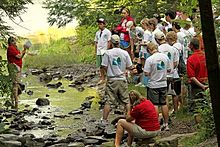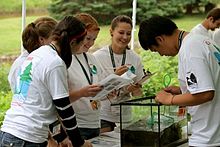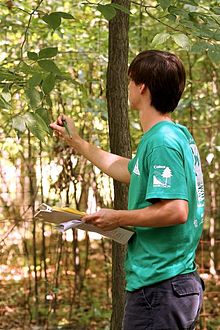Type a search term to find related articles by LIMS subject matter experts gathered from the most trusted and dynamic collaboration tools in the laboratory informatics industry.
 Logo | |
| Purpose | Environmental competition |
|---|---|
| Headquarters | Washington, D.C.[1] |
| Website | envirothon |
Formerly called | Environmental Olympics, Enviro-Olympics |
NCF-Envirothon is an annual environmentally themed academic competition for high school aged students organized by the NCF-Envirothon a program of the National Conservation Foundation. The competition is held by the United States and Canada on a regional, state, and bi-national level. In select years, the competition has also included China and Singapore. Envirothon combines in-class and hands-on environmental education[2] in a competition setting which involves a problem-solving presentation as well as written field tests. The competition tests students on five core subjects — aquatic ecology, forestry, soils and land use, and wildlife — along with a fifth annually-changing subtopic which focuses on relevant environmental issues. Currently, roughly 500,000 students from forty-five U.S. states and nine Canadian provinces/territories participate in the competition.[3]
States and provinces across the United States and Canada each have their own local competitions from which the winning high school team earns the privilege of representing their state/province at the NCF-Envirothon competition, held each summer in a different U.S. state or Canadian province. In areas with a considerable number of teams, subdivisions such as county, regional, or district competitions are also held. Teams must win these intermediary competitions in order to move on to the state/province levels.
The NCF-Envirothon is a 501(c)3 Nonprofit organization headquartered in Washington, D.C. The organization also relies heavily on volunteers across North America to advise individual teams from each participating state and province.[4] Governing the program is the National Conservation Foundation (NCF) Executive, along with a NCF-Envirothon Operating Committee which is made up of representatives from participating states and provinces.[5]
Envirothon is sponsored by the National Conservation Foundation, the National Association of Conservation Districts, the United States Forest Service, and the Natural Resources Conservation Service.[6] Individual teams are often sponsored by school clubs or classes, local businesses and governments, or 4H and other such non-scholastic organizations.[3]
Competition participants are generally teams of five students with one to two team advisers. Home-schoolers can also take part as their own team.

States and provinces across the United States and Canada each have their own local competitions from which the winning high school team earns the privilege of representing their state/province at the North American Envirothon Competition, held each summer in a different U.S. state or Canadian province. In regions with a considerable number of teams, competitions on subdivision, county, regional, or district levels are also held. Teams must win these intermediary competitions in order to move on to the state/province levels. At the North American Competition, teams that rank first through tenth receive prizes and scholarships of various values.[3]
Competition week at the NCF-Envirothon level includes various workshops, field trips, and seminars led by professionals and educators for both the students and their advisors.[7] Most of these outings are linked to the current issue topic and provide information on the area in which the competition is being held.
During the competition, each team must complete five written field tests, each dealing with a different topic. These tests consist of various question types, including identifications and hands-on assessments. Each team must also prepare an oral presentation on the current issue topic, which the team presents to a panel of judges. An important element of the competition is the understanding that each topic is interrelated, and understanding human effects on the environment and how human activities connect with ecosystem functions. Each test is scored out of 100 points, with the presentation being scored out of 200 points. The team with the highest cumulative total of points at the end of the scoring is the winning team. Recognition is also given to teams with the highest scoring in each of the five categories.[3]
The location of the North American competition is determined based on a regional map that separates North America into five general regions: Far West, Mid-West, Southeast, Northeast, and Far North. The host college or university is usually located in a different region than that of the year preceding it.[8] For example, a competition (2013) was held in at Montana State University in Bozeman, Montana in the Far West.[9]
Each field test dealing with one of five competition topics requires both theoretical understandings and hand-on skills such as identification and chemical testing. Each topic also has a degree of relatedness to one another, which is sometimes considered in theoretical-based test questions.[3][10]
Source:[11]

Source:[12]


In 1979 the Pennsylvania Soil and Water Conservation Districts set up the Environmental Olympics, later renamed Enviro-Olympics, to encourage interest in environmental issues through hands-on competition.[5] Expanding rapidly to include forty conservation districts by 1987, it gained attention from other states, and in 1988, the program became the National Envirothon, with participation from Pennsylvania, Massachusetts, and Ohio. In 1992 Nova Scotia became the first Canadian province to join the competition. The competition was sponsored by various state, local, and provincial conservation programs and associations until 1997 when Canon Inc. began its support of the program, with local sponsors still supporting lower level competitions.[3] In 1999 Canon became the title sponsor of the competition between the U.S. states and Canadian provinces, with the competition being renamed the "Canon Envirothon." It is currently referred to as the "NCF-Envirothon."[3]
Hosts and top-five competition place winners from past North American Envirothon competitions:
| Year | Host | 1st Place | 2nd Place | 3rd Place | 4th Place | 5th Place |
|---|---|---|---|---|---|---|
| 2023[16] | Mount Allison University | Massachusetts | Pennsylvania | Ontario | Florida | New Mexico |
| 2022[17] | Miami University, Oxford, Ohio | Massachusetts | Maryland | Florida | New York | North Carolina |
| 2021[18] | Nebraska Association of Resources Districts | New York | North Carolina | South Carolina | Massachusetts | Florida |
| 2019[19] | North Carolina State University, Raleigh, North Carolina | Virginia | North Carolina | Pennsylvania | New York | Mississippi |
| 2018[20] | Idaho State University, Pocatello, Idaho | New York | Montana | Virginia | New Mexico | South Carolina |
| 2017 | Mount Saint Mary's University, Emmitsburg, Maryland | Pennsylvania | New York | New Mexico | Missouri | Ohio |
| 2016 | Trent University, Peterborough, Ontario | Ontario | Pennsylvania | California | Missouri | Maryland |
| 2015 | Missouri State University, Springfield, Missouri | Missouri | Pennsylvania | Texas | Massachusetts | New York |
| 2013 | Montana State University, Bozeman, Montana | New York | Massachusetts | Missouri | New Hampshire | Mississippi |
| 2012 | Susquehanna University, Selinsgrove, Pennsylvania | Missouri | Ontario | North Carolina | Ohio | New York |
| 2011 | Mount Allison University, Sackville, New Brunswick | Manitoba | Ontario | South Carolina | New Brunswick | Connecticut |
| 2010 | California State University, Fresno, California | California | Delaware | Minnesota | Florida | Maryland |
| 2009 | University of North Carolina, Asheville, North Carolina | Pennsylvania | North Carolina | Maryland | Delaware | Missouri |
| 2008 | Northern Arizona University, Flagstaff, Arizona | Delaware | Missouri | Pennsylvania | New York | Ohio |
| 2007 | Hobart and William Smith Colleges, Geneva, New York | Connecticut | Pennsylvania | Delaware | Missouri | New Jersey |
| 2006 | University of Manitoba, Winnipeg, Manitoba | Virginia | Pennsylvania | Texas | California | Ohio |
| 2005 | Southwest Missouri State University, Springfield, Missouri | Pennsylvania | Virginia | Delaware | Kentucky | North Carolina |
| 2004 | West Virginia Wesleyan College, Buckhannon, West Virginia | Florida | Virginia | New Jersey | Kentucky | North Carolina |
| 2003 | Mount St. Mary's University, Emmitsburg, Maryland | Pennsylvania | New Hampshire | North Carolina | Manitoba | Maryland |
| 2002 | Hampshire College, Amherst, Massachusetts | New Hampshire | North Carolina | Pennsylvania | Vermont | Ohio |
| 2001 | Hinds Community College, Raymond, Mississippi | Pennsylvania | Mississippi | North Carolina | New Jersey | New Hampshire |
{{cite web}}: CS1 maint: unfit URL (link)